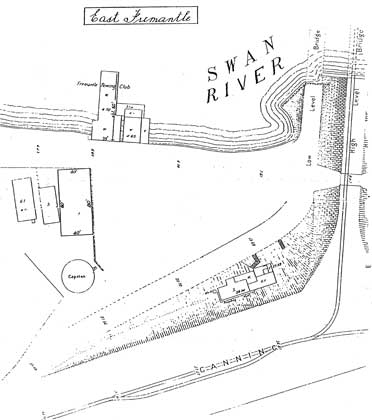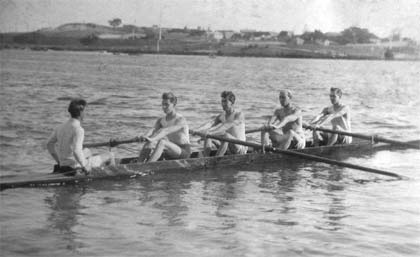History of Fremantle Rowing Club 1887-1987
By Ralph Jeffreys
Table of Contents
Chapters
- The Early Years 1887-1897
- Rowing Success 1897-1907
- The Intervention of War 1907-1917
- The New Boatshed 1917-1927
- Through to WWII 1927-1939
- Post War Rowing 1945-1957
- More Success and a New Boatshed 1957-1967
- Changing Times 1967-1977
- The End of the First Century 1977-1987
- Fremantle Ladies Rowing Club
- Boatmen and Builders
- Transport to Regattas
- Amateur Rowing Association of Western Australia
- East Fremantle Town Council
- School Rowing
- Potpourri
Appendices
4. The New Boatshed 1917-1927
Chapter Four page 1 2
During the war years the Club property had suffered severe loss and depreciation. The boat shed became unsafe owing to the ravage of the toredo in the piles and continued heavy weather. The boats were removed and stored with Mr. E. Howson and the shed was finally demolished with the exception of a portion approximately 12 feet in length which adjoined the dressing shed. This area of 12 feet contained the showers and allowed for 2 small platform for swimming activities.
Later this part of the old boat shed was completely removed and the shower area renovated with a doorway into the dressing shed and another on the outer side into about 2 feet to 3 feet depth of river. It became quite inadvisable to stand near the door to the river as it could be opened and bolted shut easily with a naked luckless oarsman having been deposited in the dark river and forced to wade around to the main doorway of the shed in order to regain entrance.
The division between the dressing shed and the boat shed was by two half inch wooden doors each approximately six feet wide and the full height of the wall. In the event of very stormy weather these doors invariably blew down and caused much inconvenience.
During 1933 Bob Williams the captain at the time organised a Working Bee, which removed the doors, strengthened the river piles and then permanently sealed the doorway space by building a wall to match the other walls of the shed. Following negotiations, Fremantle Rowing Club was given a license to occupy on the foreshore of the Swan River at Beach Street East Fremantle an area 40 feet x 80 feet. This License was granted by the Department of Works and Trading Concerns and was dated 21st January 1920. The land acquired lay between an old limestone capstan 40 feet in diameter, which had been used before the river bridges were completed and Beach Street almost opposite the existing shed over the river.
Along the upriver side of the block was an old limestone wall which no doubt had been built to establish the area used for the ropes (or chains) from the capstan. On the down river side of the block were two limestone buildings almost side by side and fronting Beach Street, one building was 40 feet x 20 feet the other 50 feet by 25 feet. It appears that these buildings were used in connection with the capstan workings.

1911 Location Plan with 1922 Boatshed Superimposed
Building of the Boat Shed began almost immediately and it was to have wooden sides, iron roof with the natural limestone floor covered with cinders from the railways coaling yards. It is of note that in later years the cinders became very powdery necessitating feet to be washed down before going into the dressing shed. Resurfacing of the floor became a constant consideration. Around this time extension of the harbour upriver was already a consideration and actually in May 1930 a drawing for the London engineering firm Sir Alexander Gibb and Partners was made available by the State Engineer in Chief Mr. F.W H. Stileman and published in the local press. Two features of the scheme were, firstly removal of the road and rail bridges to a site further up river and secondly the extension of the North and South Moles at the harbour entrance with a break in the present North Mole to allow an entrance and turning basin to an outer harbour built on what was later called Port Beach.
Had this plan been proceeded with at the time it would have meant an earlier move of the Fremantle Rowing Club. Having in mind these upriver proposals the new boatshed when designed had the walls made in sections of about 15 feet each and bolted together, this it was thought, would make easier any subsequent relocation of the site.
Under the professional eye of Frank Shaw building was commenced. Amongst the helpers were Wally Bateman, Bob Browne, Henry Ceasar, George Davidson, George Doonan, Stan Jeffreys, Alf Manuelle, Frank Sears, Bill Taylor and Ray Viner. The building was completed early in 1921 and as most of the work had been performed by "Working Bees" the cost to the Club was only 180 pounds 5 shillings (equiv. $360).
Having completed the new boat shed the boats were recovered from storage and work next proceeded with their restoration. A racing eight had been ordered from Jas. Edwards and Sons Melbourne on 2nd July 1914, but as war had been declared on 4th August 1914 and the Club had almost immediately gone into recess, the builders were requested to store the boat in Melbourne when completed. The construction of the boat sheds
having been completed Daniel, (later Sir Daniel) Aarons a former secretary of the Club then living in Melbourne
was contacted with a view to making arrangements for the eight to be transported to Fremantle. There existed,
however, a little fear that the long storage of the boat may have had an adverse effect on the structure.
The boat was located and arrangements made for shipping.
Meantime the racing four ("Strelitz") and the practice four "Dreadnought" had been
completely restored and old members returning from the war had coached the oarsmen to such an extent that the Club was able to resume Pennant Racing at a Regatta held on 14th May 1921, a Maiden 4 using "Strelitz" (now renamed F.R.C.) and a Novice 4 using "Dreadnought".
The eight from Melbourne arrived in the Clubhouse late in August 1921 it being the first eight oared boat fully housed. It is remembered the first eight ever owned was originally stored under the pine trees in the front garden of Mr. Duffield's home in Beach Street, and when the boat was later transferred to the Boat Shed. the Club "engineers" of the time designed a rack and cut a hole in the wall at the river end of the shed through which passed the bow end of the boat leaving the remainder resting on the rack in the boat shed. Up until this time only fours and pairs had been accommodated in the Boat Shed. The new eight was christened "John Moss" to honour a former secretary and enthusiastic Committee man who had lost his life serving with the A.I.F, during the War. The Club now had really entered a new era.
Amongst the most prominent of the new young men were F.H. Powell, G.C. Whittle, G.L. Davidson, W.M. Bateman, J.J. Grieve, W. Varcoe, G.G.H. Edwards, J.E.Shaw with H. Tilley Cox. The foregoing members formed the Maiden Eight, the Junior Four, Maiden Four and the Novice 4 and won the four events at the Fremantle Regatta on 5th June 1922.

1922 Maiden & Junior Four
F H Powell (str), G G Whittle (3), G L Davidson (2), W Bateman (bow), H Tilley (cox), F E Shaw (coach)
Later F.H. Powell, G.L. Davidson, W.M. Bateman and G.G. Whittle won the State Champion Four of 1924 and F.H. Powell and G.L. Davidson won the State Champion Pairs of 1924 and 1925. Subsequently Frank Powell was given a seat in the State crew of 1925 stroked by Jim Child which won decisively on the Yarra.
